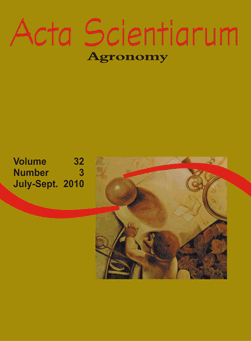<b>Analysis of the coffee harvesting process using an electromagnetic shaker</b> - doi: 10.4025/actasciagron.v32i3.6782
Keywords:
Coffee, harvesting, harvesting efficiency, ripeness stage
Abstract
Harvesting is one of the most important operations in coffee production systems. This operation has a high cost and impact on the final quality of the product. To reduce production costs, producers are looking for ways to mechanize this operation. Harvesting machines generally detach fruits from the coffee plant by vibration and/or impact. The objective of this work was to study the effect of the amplitude and frequency of vibration on the efficiency of coffee fruit harvesting. Vibration tests of coffee branches were performed in a laboratory using an electromagnetic shaker. The tests were performed using amplitudes in the range of 3.75 to 7.50 mm and frequencies from 13.33 to 26.67 Hz. Coffee branches from two different varieties were used for evaluation, Catuaí Vermelho and Mundo Novo. It was verified that harvesting efficiency is directly related to the acceleration reached by the fruits during the harvesting process. The frequencies of 23.33 and 26.67 Hz and amplitudes of 6.25 and 7.50 mm resulted in the highest harvesting efficiency of ripe coffee cherries for both varieties. However, the harvesting efficiency for the Mundo Novo variety was higher than that of the Catuaí Vermelho variety at the studied frequency and amplitude ranges in this work.Downloads
Download data is not yet available.
Published
2010-08-25
How to Cite
Santos, F. L., Queiroz, D. M. de, Pinto, F. de A. de C., & Santos, N. T. (2010). <b>Analysis of the coffee harvesting process using an electromagnetic shaker</b> - doi: 10.4025/actasciagron.v32i3.6782. Acta Scientiarum. Agronomy, 32(3), 373-378. https://doi.org/10.4025/actasciagron.v32i3.6782
Issue
Section
Agricultural Engineering
DECLARATION OF ORIGINALITY AND COPYRIGHTS
I Declare that current article is original and has not been submitted for publication, in part or in whole, to any other national or international journal.
The copyrights belong exclusively to the authors. Published content is licensed under Creative Commons Attribution 4.0 (CC BY 4.0) guidelines, which allows sharing (copy and distribution of the material in any medium or format) and adaptation (remix, transform, and build upon the material) for any purpose, even commercially, under the terms of attribution.
2.0
2019CiteScore
60th percentile
Powered by 

2.0
2019CiteScore
60th percentile
Powered by 



















































